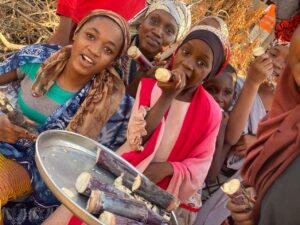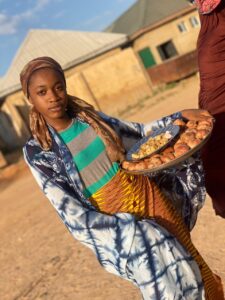The interpretation of some items like the food and the symbolic representation of the costumes and art forms used by the youth during Qauyawa
Qauyawa day as a traditional, cultural event is done to represent the life and attires of the villagers or their cultures. During this event, the bride is dressed up looking all gorgeous but making sure that she is in her traditional attire, dressing the bride up in not just atamfa but the olden day style of wearing atamfa, with a shirt, a wrapper, a scarf, and another wrapper or head tie draped on top of her head together with some traditional beads and glamour.
As for the bride maids and friends, or family they come dressed in a shirt, a different skirt or wrapper from the shirt, a different scarf, tied in an olden way and their make-up are also just like the villagers that are, very sooty lipstick, eyeliner, eyebrow, a dot on the forehead and some lines on the cheek. This mode of dressing depicts the simplicity of the life of the rural people.
Considering the fact that culture is a system of self-definition that symbolises the way we eat, the way we dress and the way we relate to one another, the food items used during Qauyawa day are all symbolic representations of a typical Hausa society and they all have significance within the context of Qauyawa rites. It was discovered that food items like goruba, (Doulm palm), aduwa (soap berry), magarya (Ziziphus Mauritiana), goro (kolanut), dambu (grits from whole grain), sugarcane, and more are used for medicinal purposes as well as nutritious reasons.

goruba, (Doulm palm) ya na maganin hawan jini da kansa, it is used to cure hypertension and cancer, Aduwa (soapberry) Ya na maganin cuta casa’in da tara it cures 99 ailments. Rake (Sugar cane) yana wanke koda, it cleans the kidney.
This symbolises that the Hausa people believe that it is mandatory for them to get their children married without any form of ailment or deformity. Hence, the significance of the above fruits. It is also done to showcase to the new generation or the indomie generation the ancient foods which they are not aware of.

Art Forms and Symbols associated with the Qauyawa day
There are various art forms that are portrayed during the celebration of Qauyawa day. Each of these art forms, as observed, could be placed under either of the two main art forms: performing arts and visual art. In this categorisation, the most dominant art forms observed during the ceremonies that can be placed under performing arts were drama, singing, and dancing. On the other hand, those art forms observed at the ceremony that came under the category of visual arts were the clothing and appearance of the bride in public, the make-up and henna design are more pronouncedly seen, the use of varying colours and types of beads during the celebrations are also observed.
Costume and Henna design
The use of costumes or the mode of dressing during the occasion is traditional or imitations of olden days or rural way of life. During the event, the bride changes herself about three or four times imitating the villagers for admiration, not mockery. The clothing is simple and the bride will appear with specially prepared beads on the neck and on both wrists.
Nowadays, most of the brides go for the new henna designs as opposed to the olden days’ styles. In the olden days, there are no such new designs and the henna is put in Zunguru, a calabash container where the woman will then put her hands. The henna is used in order to cleanse and beautify the bride. It also signifies the appearance of the newly branded bride. Although all the bridal clans also go for a henna design, the bride’s design is the outstanding one and it supersedes every other person’s design.
The makeup, usually, a dot on the forehead and some lines on the cheek are imitations of the marks donned during the olden days. According to an old mama:
Alokacin mu Idan ba ka da tsaga ko zane irinsu kalangu ko fashin goshi to alama ce ta ragwanta. (During our time lack of marks signifies cowardice).
She further asserts that even though there are marks that are inherited most times they themselves go for such marks during their youthful ages to express their bravery.
Singing and Dancing
Singing and dancing form an integral part of the Hausa culture. Hausa people are musical people. It can thus be explained that singing and dancing are used by the Hausa people not only for the sake of entertainment but also to express themselves. At occasions such as wedding ceremonies, singing and dancing are used to portray the mood of the couple’s families to society. As typical of most tribes in Nigeria, the Hausas also use singing and dancing to show their mood, particularly their joyful moods.
Hence, we sing when we are happy, and a few times when we are sad. The type of songs and dancing one performs tells our people our mood. In our marriages, therefore, we use singing and dancing to show how happy we are to the outside world. We use our music to show how we support the new union of our son and our daughter.
However, it was discovered that technology and modernisation have influenced the singing and dancing modes during the event of Qauyawa day as observed by the writer because out of the ten Qauyawa days observed, only three used the normal kalangu (drum) and masu amada. (Calabash drummers). All the remaining seven used DJ and Mp3, where various music were played including English music.
The above observation bears semblance with the picture painted by Ngugi, and their likes when they stated that cultural crisis is essential when there is dominance, through modern technology. In this respect, there is an aspect of the culture that has undergone mutation in response to globalisation and westernization, for instance, the replacement of Kalangu with DJ.
The Connotation and place of Qauyawa Day
Hausa society is fluid, informality prevails, Qauyawa day which is a recent innovation in the marriage rituals of the Hausa people is: A depiction that in life there is that sense of sacrifice, sense of purity, that burning mission of giving up things, that is, the urge to give up the urban method of life. There is also that sense of being proud of being different, that sense of embracing one’s body and stop believing in materialisation/materialism. It also denotes freeing one’s artistic self and surprising oneself through living an unconventional lifestyle.
From our findings, it may be safe to consider Qauyawa day rite as an aspect of contemporary culture, considering the fact that contemporary culture refers to current shared themes, beliefs, and values of the society. It includes present practices, trends as well as political and social beliefs. Understanding contemporary culture is the key if one wants to identify society’s future trends and values.
Contemporary culture, through creative expression, enables us to express how we view the world. However, technology has evolved and become so advanced that humanities are taught in ways that are appealing to people.
The aspects of contemporary culture have influenced the humanities and creative expression by letting us create something that we feel needs to be heard, seen, or felt. They help us express how we sense the world spiritually and intellectually.
I think the main value of this human creative expression is the way it has allowed us to interact with one another. We are able to keep in contact with friends and family or reconnect with people we have not seen in a while. We feel a part of others’ lives because we share moments such as this current rite of Qauyawa day.
One of the arguments of the writer is that gradually, some of the olden days’ traditions are paving back through events such as this because Qauyawa day is a reconciliation between the past and the present by establishing a synergy between the rural way of life and that of the urban. This also buttresses the point that Hausa people create, maintain, and sustain their traditional cultural norms and values in the modern time, despite the infusion and intrusion of modern and foreign cultures into their society.
To sum it up, Qauyawa day is an aspect of contemporary culture that is appalling, appealing, and powerful because of its nature of employing symbolic logic through entertainment which is a pleasurable activity. Entertainment has been an integral part of human life since the beginning of life. Social as well as cultural learning is embellished in the activities of Qauyawa day such as eating the medicinal fruits, the make-up, and related efforts. Qauyawa day tried to establish the nexus between the new and the older culture through entertainment and edutainment.
Dr Hauwa Mohammed Sani is from the Department of English and Literary Studies, Ahmadu Bello University, Zaria, and can be reached via Email: hmsani@abu.edu.ng or hauwamohammedsanim@gmail.com.
Follow the Neptune Prime channel on WhatsApp: https://whatsapp.com/channel/0029Va74ZvU2v1IqKByXoX3d
Do you have breaking news, interview request, opinion, suggestion, or want your event covered? Email us at neptuneprime2233@gmail.com



Allah ya kara Basira
Indeed, it is a captivating and plausible research. Of its important, our cultural practices are given ground to preservation. A traceable way of recording our past in relation to our present day generation. I pique interest in such an academic domain, much especially, the area that transmits my cultural norms and values using another language. A wonderful job! Thank you for the contribution.